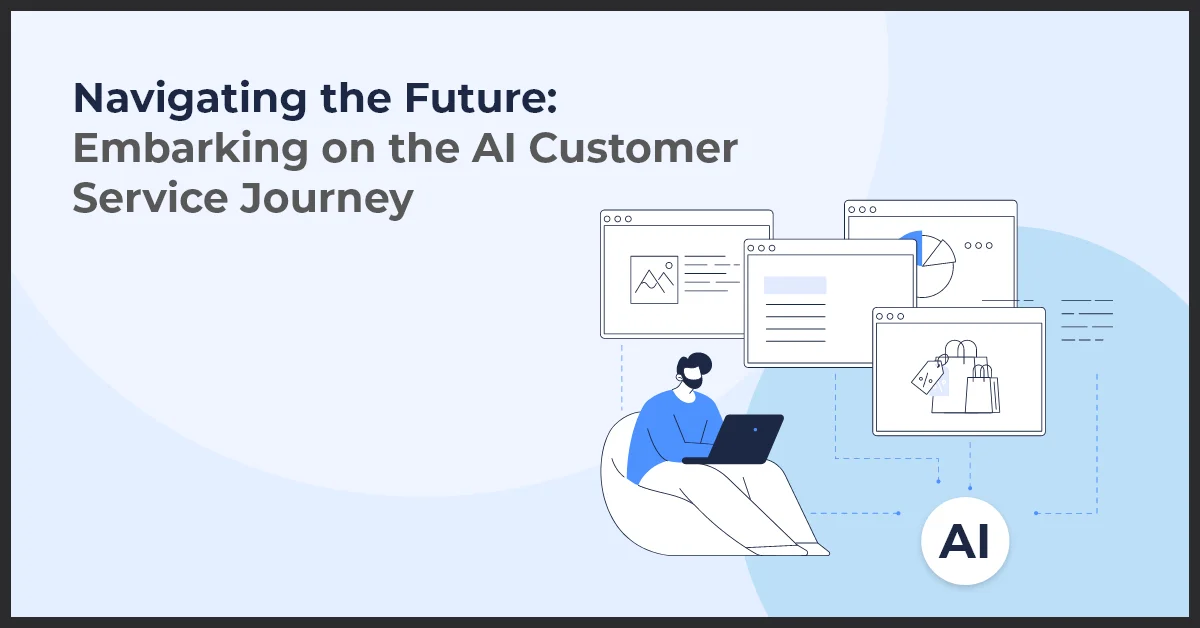Navigating the Future: Embarking on the AI Customer Service Journey

Published on: July 12, 2024
Updated on: October 24, 2024
907 Views
- Digital Marketing
13 min read
Welcome to the era where artificial intelligence transforms customer service into an always-on, responsive companion. Chatbots, powered by sophisticated AI algorithms, are redefining the way businesses interact with their customers. These virtual helpers are not mere programs but are designed to simulate human conversation, learning over time to better handle inquiries and provide assistance.
Delve into the realm of voice assistants, where spoken queries get real-time responses, thanks to advances in voice recognition technology. The presence of these tools in customer service is more than a convenience; it's a new standard that offers significant benefits.
Engaging with chatbots leads to an improved customer experience, as they can handle a vast array of questions without the need for a human agent to step in. This doesn’t just improve response times; it also frees up human agents to tackle more complex issues, thereby enhancing the overall efficiency of the support team.
Imagine a world where your customer queries are addressed at any hour, without delay. AI makes this possible, offering round-the-clock support and meeting the ever-growing consumer demand for immediate solutions. Through a series and array of examples, we see businesses large and small tapping into the potential of AI for continuous customer support, ensuring no customer is left without a helping hand whenever they need it.
The Foundations of AI Customer Service: NLP and Machine Learning
Exploring the Role of Natural Language Processing
Natural Language Processing (NLP) stands as a pillar in the AI customer service domain. By simulating the capacity to understand human language, NLP allows computer programs to interpret, analyze, and respond to user queries with a high degree of accuracy. This transformation lies at the roots of today’s innovative customer support solutions.
How NLP Enables Understanding of Customer Conversations
NLP technologies harness models trained on vast datasets, facilitating the coherent interpretation of semantics and the intent behind customer communications. This proficiency enables AI customer service tools to engage in conversations, answer questions, and resolve issues with a semblance of human interaction.
Machine Learning Algorithms at Work
Machine Learning (ML) algorithms adapt through experience. These algorithms mine data from customer interactions, learning to predict responses and actions effectively. The continuous refinement of algorithms ensures incremental improvement in customer service interactions over time.
Pattern Recognition and Predictive Analytics in Service
In the context of AI customer service, robust pattern recognition capacities streamline workflows. Predictive analytics leverages these patterns to forecast customer needs, ensuring AI systems offer proactive and targeted support, which translates into more efficient resolutions.
Case Studies of ML Improving Customer-Business Interactions
- Zendesk: ML powers its automatic responses, learning from past interactions to improve the accuracy of future communications.
- Bank of America’s Erica: This virtual assistant employs predictive analytics to provide personalized banking advice to millions of users.
- Accenture's chatbot Ella: Ella uses NLP to decode complex customer queries and provide relevant solutions.
Personalization at the Heart of Customer Experience
With AI at the forefront, customer service realms are witnessing a shift towards hyper-personalized experiences. These AI systems harness vast amounts of data, preferences, and past interactions to deliver services that feel tailor-made for each customer. Contrary to uniform responses, this trend signifies a move towards uniquely crafted engagements for every individual.
The Power of AI-driven Personalization
AI-driven personalization redefines how services cater to clients by analyzing customer data to predict needs and preferences. An AI that learns a customer’s buying habits can suggest relevant products or services, transforming a routine interaction into a tailored experience. Customer service enabled by AI doesn't just respond to inquiries; it anticipates needs and streamlines the journey.
Tailoring Experiences to Individual Customer Needs
Understanding specific customer requirements allows AI-driven services to adapt dynamically. For instance, if a customer frequently contacts support regarding particular issues or at specific times, AI tools schedule proactive outreach or offer specialized assistance during those periods, adapting their operations to fit individual patterns and preferences.
Benefits of Personalized Customer-Agent Interactions
- AI customization creates a sense of value among customers, who feel understood and appreciated. This personalized touch increases satisfaction and encourages continued use of a service.
- Personalized interactions foster deeper client-agent bonds, laying the groundwork for increased trust and deeper brand loyalty.
- Data-driven personalization equips agents with the context needed to resolve queries efficiently, leading to higher resolution rates and swifter service.
Through the deployment of sophisticated AI algorithms, companies ensure that customers encounter a service ecosystem that feels inherently familiar, responsive, and efficient. By addressing the individual rather than the collective, AI customer service elevates the customer experience to new heights.
Unlock Seamless Brand Experiences with Omnichannel Engagement
Have you ever enjoyed a shopping experience so cohesive across a brand’s website, social media, and in-store that you couldn't help but return? That’s omnichannel customer engagement in action. By leveraging data and analytics, companies create a unified customer experience, whether the touchpoint is online or offline. Customers expect to receive personalized service when, where, and how they prefer, and brands that meet these expectations foster stronger loyalty.
Integrated Experiences Across Platforms
Customers switch between devices and channels with ease, often starting an interaction on one device and completing it on another. Maintaining continuity throughout these transitions is paramount. An integrated customer experience ensures that whether a customer is on a desktop, browsing a mobile app, or walking into a brick-and-mortar store, they feel recognized and valued without any disjointed transitions.
How AI Facilitates Seamless Service Across Channels
Artificial intelligence analyzes vast amounts of data to understand customers’ buying behaviors, preferences, and history. This data powers personalized recommendations and interactions across all channels. AI supports live customer service agents by providing real-time information and action prompts, creating a harmonious blend of human touch and automated efficiency. When customers receive swift, informed responses to their inquiries, their trust in the brand solidifies.
- AI chatbots on messaging apps can resolve issues or escalate to human representatives without missing a beat.
- Virtual assistants on smart devices provide help and guidance, syncing with user accounts for a tailored experience.
- Email and text notifications, powered by AI, update customers on their order status, keeping communication lines open.
Moreover, integrating AI across all customer service channels means that any interaction can pick up right where the last one left off, with all relevant information at the ready. When a customer feels recognized and valued across every channel, they are more likely to develop a connection with the brand, resulting in repeat business and referrals.
Behind the Scenes: Automation and Analytics in Customer Service
Imagine a powerhouse working tirelessly, sorting out customer inquiries, processing information, and optimizing experiences—all without a coffee break. That's automation in customer service. Its role cannot be underestimated, as it transforms the landscape of support and interactions. With processes mechanized, businesses handle an avalanche of tasks with unprecedented efficiency.
Streamlining Tasks with Automation in Customer Service
Automation doesn't just alleviate workload; it transfigures job roles. Customer service agents find relief from monotonous tasks, empowered to tackle complex issues that require a human touch. The mundane processes? They're now swiftly handled by sophisticated algorithms, allowing businesses to focus on strategy and growth.
How Automation Can Resolve Common Service Requests
Consider the sheer volume of repetitive inquiries that customer service agents encounter daily. Automated systems are designed to tackle FAQs, account updates, and tracking information. Customers are afforded instant gratification with immediate solutions, augmenting satisfaction and cutting down on the need for direct human intervention.
Utilizing Customer Service Analytics
Unnoticed by customers but vital for strategic decisions is data analytics. Systems continuously learn from interactions, providing invaluable insights. Patterns emerge, revealing what customers desire, detest, and the efficiency of various service touchpoints. These data points guide the evolution of customer service protocols.
Gleaning Insights to Enhance Service Strategies
Analytics offer more than a rearview mirror glimpse into operational performance. They forecast customer behavior, inform product development, and elevate service blueprints. Brands harness these insights not just to react to trends but to anticipate and shape future consumer expectations.
As agents partner with AI, deploying both automation and analytics, service transforms. Customers enjoy swift issue resolution; businesses revel in optimized operations. In the data, the groundwork for tomorrow's service excellence is laid down, piece by piece, interaction by interaction.
Unveiling Patterns with AI-Driven Insights
Diving into customer data, AI lays bare patterns and trends that would otherwise go unnoticed. With machine precision, each interaction is processed to reveal customer needs and preferences. This comprehensive insight allows companies to tailor services and predict future behaviors, forging a path to truly proactive customer service.
Leveraging AI for Comprehensive Customer Understanding
By scrutinizing past interactions and feedback, AI systems extrapolate the nuances of consumer behavior. Businesses harness this to adjust offerings, ensuring they align with evolving expectations. Such depth of understanding translates directly to enhanced customer satisfaction and loyalty.
Predictive Analytics: Anticipating Needs
AI doesn't just inform businesses about the present; it casts its gaze into the future. Predictive analytics anticipates customer queries and concerns, enabling a service that not only reacts but also preempts. Companies that implement this strategic foresight often see increased efficiency and higher service quality scores.
From Data to Strategy: The AI Alchemy
The true magic of AI lies in its ability to turn vast data lakes into goldmines of actionable intel. Strategies once based on hunches or limited analysis now stem from comprehensive data-driven insights. The result? A strategic roadmap finely tuned to navigate the market's complex terrain with the assurance of data-backed decisions.
- AI deciphers customer feedback, highlighting satisfaction drivers and pain points.
- Customer service interactions are analyzed to trim down response times.
- Purchase patterns fuel bespoke marketing campaigns, securing better ROI.
Gaining a holistic view of customer journeys, AI's analytical prowess equips businesses with the tools to sculpt offerings for optimal impact. With predictive analytics guiding the way, companies not only stay ahead of the curve but also create experiences that resonate on a personal level.
Unlocking Fiscal Prudence with AI Customer Service
Businesses integrating AI into their customer service workflows uncover substantial operational cost reductions. These savings materialize through streamlining mundane tasks, allowing human customer service agents to focus on more complex and nuanced issues. Automation leads to faster resolution times and a decrease in the volume of repeat inquiries.
Deploying AI solutions, such as chatbots and intelligent virtual assistants, drives efficiency by automatizing responses to frequently asked questions and simple requests. This shift not only frees up human resources but also minimizes the need for extensive staffing to handle peak load times or after-hours queries. As a result, businesses often observe a dip in labor costs without compromising service quality.
- Implementing AI chatbots can redirect routine customer inquiries, reducing the burden on live agents.
- AI systems are capable of continuous operation, eliminating downtimes associated with human fatigue and availability.
- Advanced AI tools analyze and optimize customer interactions to enhance resolution strategies over time.
Furthermore, AI-driven analytics can identify operational inefficiencies, guiding managers to make informed decisions about resource allocation and process improvements. By targeting these inefficiencies, organizations not only cut expenses but also amplify customer satisfaction, turning a well-balanced wheel of cost-efficient service and improved business outcomes.
The Future of Customer Service is Self-service
Recent trends indicate a shift towards self-service platforms, transforming the way individuals interact with companies. Rapid advancements in technology empower customers to resolve their queries and issues without human intervention. This self-reliant model not only satisfies the instantaneity that today's consumers demand but also streamlines operations for businesses globally.
With self-service, customers can navigate troubleshooting protocols, access account information, and manage transactions at their convenience. The proliferation of comprehensive knowledge bases, interactive FAQs, and sophisticated diagnostic tools embedded within these platforms means users can usually find the answers they’re looking for at any time of day.
Further enhancing the capacity of self-service platforms is multilingual customer support powered by sophisticated AI. These systems deliver accurate and contextual translations, enabling users across different linguistic backgrounds to benefit from the same high-quality service. By breaking down language barriers, services become more accessible and inclusive, catering to a diverse global customer base.
- Self-service platforms facilitate swift issue resolution.
- Knowledge bases and FAQs are dynamically evolving to be more intuitive and informative.
- AI-driven multilingual support extends service accessibility to non-native speakers.
Contact centers were once the primary touchpoint for customer support; today's self-service structures are rapidly taking over that mantle. As organizations continue to integrate AI and machine learning technologies, self-service capabilities will continue to expand, making them an even more integral part of customer service ecosystems.
Embracing the Shift: Transition to AI-enhanced Customer Service
For organizations preparing to integrate AI into existing customer service systems, several key considerations ensure a seamless transition. Assessing current infrastructure paves the way for identifying requisite upgrades or replacements, ensuring compatibility with AI technologies. Factors such as database structure and software interconnectivity demand attention to facilitate efficient AI deployment.
Training and development stand as pivotal elements in the AI-augmented service landscape. Service agents must receive education on navigating AI tools, interpreting their insights, and delivering informed responses. Emphasis on human empathy and problem-solving complements AI's data-driven suggestions, striking a balance in the customer service equation.
Peering into the future of AI in customer service unveils a panorama of evolving trends and emerging technologies. Anticipate advancements in natural language processing and machine learning algorithms to enhance the understanding and anticipation of customer needs. Further, the integration of augmented reality and virtual reality stands poised to revolutionize remote assistance and customer interaction.
Revolutionizing Engagement with AI Customer Service
As businesses navigate through the tech-infused era, artificial intelligence reshapes customer and business interactions fundamentally. The upgrade from conventional methods to AI-enabled interfaces delivers a seamless, efficient, and often more empathetic customer service experience. Companies that implement AI customer service tools observe measurable improvements in response times, issue resolution rates, and customer satisfaction.
Adapting to this evolving digital landscape requires organizations to embrace a culture of perpetual learning and innovation. The integration of sophisticated AI customer service solutions is not a one-time event but a dynamic process that demands constant refinement and training. This adaptability can secure a competitive advantage and position companies at the forefront of consumer-centric innovation.
Your Next Step Towards Customer Service Excellence
Reflect on the current service model your organization employs. Does it harness the full potential of AI to enhance customer interactions? If the prospect of upgrading to AI-powered customer service resonates with the strategic goals of your business, ample resources and specialized expertise are at your disposal to initiate or advance this transition.
For comprehensive guidance on implementing AI in your customer service operations, reaching out to experts in the field is a strategic move. Numerous case studies substantiate the effectiveness of AI in boosting customer service metrics, while firsthand accounts from industry veterans offer insights into best practices and common pitfalls. Incorporating AI doesn't just solve existing problems — it uncovers opportunities to redefine what excellent customer service means for your business.
Advancements in AI are not coming; they have arrived, compelling service providers to evolve. For those ready to take the next step, numerous resources are available. From detailed guides to hands-on consulting, the tools for implementing sophisticated AI customer service solutions are at your disposal.
Contact industry experts, invest in developing AI capabilities, and join the vanguard of businesses redefining customer service excellence. The shift to AI-enhanced customer service is not just about keeping up—it's about leading the way in a world where customer engagement is rapidly transforming.
Frequently Asked Questions
AI in customer service refers to the use of artificial intelligence technologies, such as chatbots, virtual assistants, and machine learning algorithms, to automate and enhance customer interactions.
AI can be used for customer service by providing instant responses through chatbots, automating routine inquiries, personalizing customer interactions, analyzing customer sentiment, and predicting issues to offer proactive support, thereby enhancing efficiency and customer satisfaction.
AI will not replace customer success but will augment it. AI can handle routine tasks and provide insights, allowing customer success teams to focus on building relationships, addressing complex issues, and delivering personalized experiences that require human empathy and understanding.
AI can improve customer service by providing instant responses, 24/7 availability, personalized interactions, efficient issue resolution, and predictive insights to anticipate customer needs.
Common applications include chatbots for handling inquiries, virtual assistants for personalized support, AI-driven analytics for customer insights, and automated ticketing systems for issue management.
Benefits include faster response times, reduced operational costs, improved customer satisfaction, consistent service quality, and the ability to handle large volumes of inquiries simultaneously.



